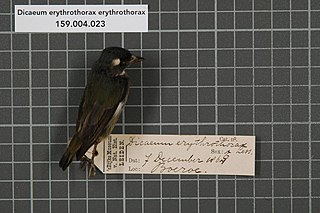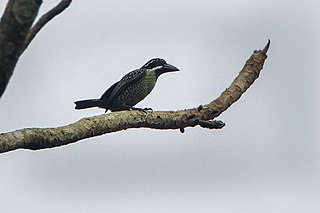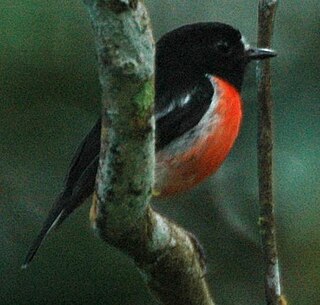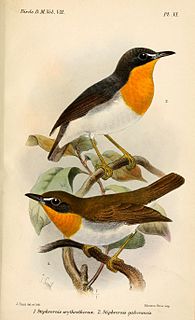
The common bulbul is a member of the bulbul family of passerine birds. It is found in north-eastern, northern, western and central Africa.

The South Island robin, is a sparrow-sized bird found only in New Zealand, where it has the status of a protected endemic species. The birds are sparsely distributed through the South Island and Stewart Island/Rakiura, although the distribution is not continuous. The nominate, and the Stewart Island robin are the two subspecies. The species is closely related to the North Island robin, and also to the extremely rare black robin of the Chatham Islands.
The Sangha forest robin is a subspecies of the forest robin that is endemic to south-western Central African Republic, but may also occur in adjacent parts of DR Congo, Cameroon and Republic of the Congo. It was only discovered in 1996, and scientifically described in 1999. When recognized as a species by IUCN, it was considered data deficient, but following recommendations by the BirdLife Taxonomic Working Group, IUCN now consider it a subspecies of the forest robin. It has been described as common.

The black-capped lory also known as western black-capped lory or the tricolored lory, is a parrot found in New Guinea and adjacent smaller islands. It is a colourful and relatively robust lory. There are seven subspecies, all with green wings, red heads and body around the wing, a black cap, grey-black cere, yellow underwings, and blue legs and belly. Most also have a blue nape and mantle. It remains overall widespread and common, but the subspecies cyanuchen is relatively rare, with fewer than 5,000 individuals remaining.

The chestnut-necklaced partridge is a species of bird in the family Phasianidae. It is found in forests in the Malay Peninsula, Sumatra and Borneo. It is threatened by habitat loss and trapping. The International Union for Conservation of Nature (IUCN) has assessed it as vulnerable.

The olive ibis is a species of ibis native to dense tropical forests in central Africa. Between 65 and 75 cm in length, it is a small ibis with predominantly olive plumage with iridescent sheen. Four subspecies are recognized.
The long-billed forest warbler, also known as the long-billed tailorbird, is a songbird of the family Cisticolidae, formerly part of the "Old World warbler" assemblage. It is found in Tanzania and Mozambique. Its natural habitat is subtropical or tropical moist montane forests. It is threatened by habitat destruction.

The Nilgiri blue robin, also known as Nilgiri shortwing, white-bellied shortwing, Nilgiri sholakili or rufous-bellied shortwing is a species of passerine bird in the family Muscicapidae endemic to the Shola forests of the higher hills of southern India, mainly north of the Palghat Gap. This small bird is found on the forest floor and undergrowth of dense forest patches sheltered in the valleys of montane grassland, a restricted and threatened habitat.

The Buru flowerpecker is a species of bird in the family Dicaeidae. It is endemic to the Maluku Islands in Indonesia. Its natural habitats are subtropical or tropical moist lowland forest and subtropical or tropical moist montane forest. It is restricted to Buru.
The black-eared ground thrush is a species of bird in the family Turdidae. It is found in Cameroon, Democratic Republic of the Congo, Equatorial Guinea, Gabon, and Uganda. Its natural habitats are subtropical or tropical moist lowland forests and subtropical or tropical moist montane forests.

The hairy-breasted barbet is a species of bird in the family Lybiidae. It is found throughout the Africa tropical rainforest.

Bates's paradise flycatcher is a passerine bird belonging to the monarch-flycatcher family, Monarchidae. The sexes are similar in appearance with the upper parts being rufous and the head and underparts being bluish-grey. It is native to central Africa where it is found in the understorey of forests.

The white-bellied blue robin or white-bellied sholakili, is a bird of the family Muscicapidae. It is endemic to the Shola forests of the higher hills of southern India. The Nilgiri blue robin and this species were once considered separate species, later lumped as sub-species of a single species (major) and elevated again to full species in 2005 by Pamela C. Rasmussen. The species was earlier thought to be related to the shortwings and placed in the genus Brachypteryx and later moved to Myiomela since species in the genus Brachypteryx shows marked sexual dimorphism. In 2017, a study found that this is a sister group of the flycatchers in the genera Niltava, Cyornis and Eumyias among others. It was then placed in newly erected genus Sholicola. This small bird is found on the forest floor and undergrowth of dense forest patches sheltered in the valleys of montane grassland, a restricted and threatened habitat.

The Pacific robin, is a red-breasted Australasian robin in the passerine bird genus Petroica found in Melanesia and Polynesia. It is similar in plumage to the scarlet robin of Australia, and until recently the two were considered conspecific until split in 1999 by Schodde and Mason. Thirteen subspecies of Pacific robin are currently recognised, and these subspecies display considerable variation in plumage, foraging preferences, and habitat. The Norfolk robin was previously considered a subspecies of the Pacific robin, but is now considered a distinct species.

The Roraiman antbird is a species of passerine bird in the family Thamnophilidae.

The olive-backed forest robin is a subspecies of the forest robin found in the Gamba Complex in southwest Gabon. It was described in 2008. The olive-backed forest robin can be separated from other subspecies of the forest robin by the combination of its olive upperparts, bright orange throat and chest, and cream-yellow belly. Its song is also distinct from other subspecies of the forest robin. Females are generally duller than males. It has not been evaluated by IUCN, but has been described as locally common.

The western forest robin is a subspecies of the forest robin found at low levels in West African forests from Sierra Leone to Nigeria. It has been placed in the family Turdidae, but is now generally placed in Muscicapidae. It commonly includes the other members in the genus Stiphrornis as subspecies, in which case the common name for the "combined species" simply is forest robin. The western forest robin can be separate from the other members of the genus by the combination of its deep orange throat and breast, white belly, and olive upperparts. It also appears to differ vocally from the other members in the genus, but a comprehensive study on this is lacking. When considered conspecific with the other members from its genus, S. erythrothorax is considered to be of least concern by IUCN. While not rated following the split into several species, it has been described as frequent to locally abundant, and is therefore unlikely to qualify for a threatened category.

The forest robin or orange-throated forest robin is a species of bird from Central and West Africa. It is monotypic in the genus Stiphrornis. It has been placed in the family Turdidae, but is now generally placed in Muscicapidae in the group popularly known as chats. Most taxonomists consider it a single species, but some reviews have recommended recognizing 5 species. It has a total length of around 12 cm, has dark upperparts, and a throat and chest that, depending on the subspecies, is yellow-orange or deep orange.

The eastern forest robin is a subspecies of the forest robin found at low levels in forests from Cameroon and Gabon to DR Congo and Uganda. In 1999 it was recommended that it should be treated as a separate species instead of a subspecies. IUCN and some other authorities do not recognize the split, and consequently it has not been rated as species separate from S. erythrothorax. However, it has been described as frequent to locally abundant, and is therefore unlikely to qualify for a threatened category.
The Dzanga-Ndoki National Park is located in the southwestern extremity of the Central African Republic. Established in 1990, the national park is 1,143.26 square kilometres (441.42 sq mi). The national park is split into two non-continuous sectors, the northern Dzanga sector 49,500 ha and the southern Ndoki sector 72,500 ha. Notable in the Dzanga sector is a gorilla density of 1.6/km2 (4.1/sq mi), one of the highest densities ever reported for the western lowland gorilla.














